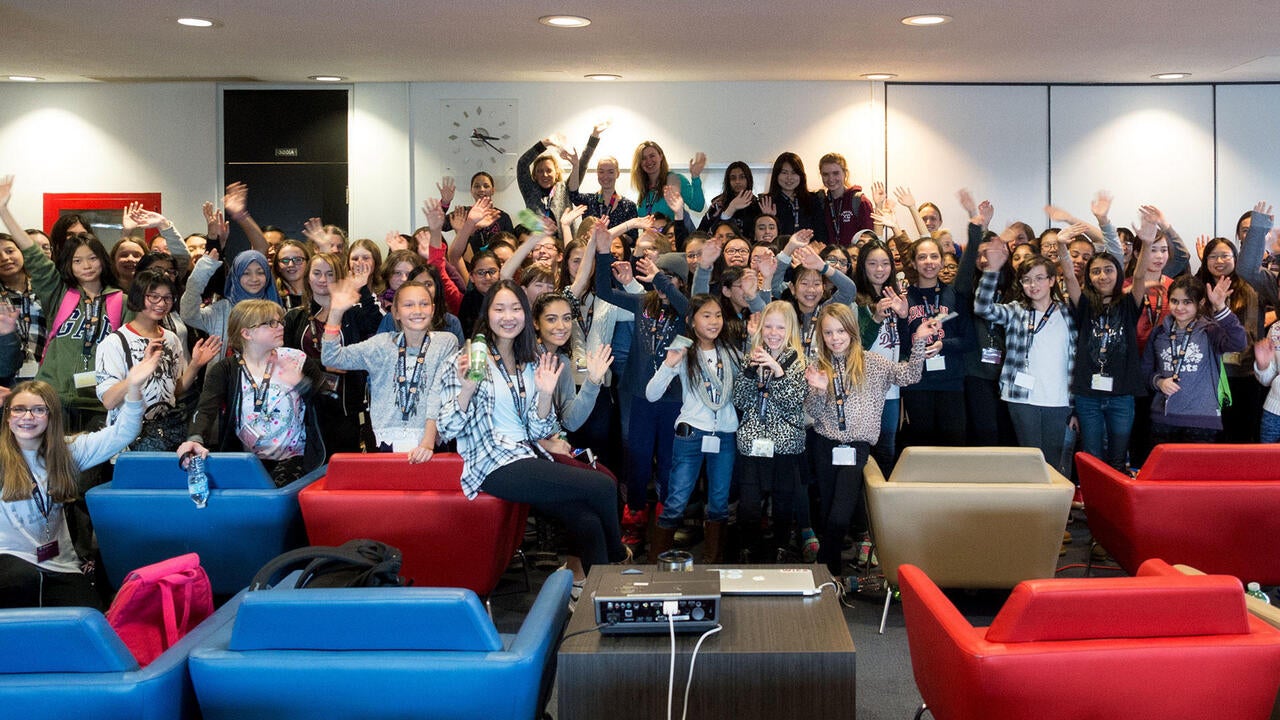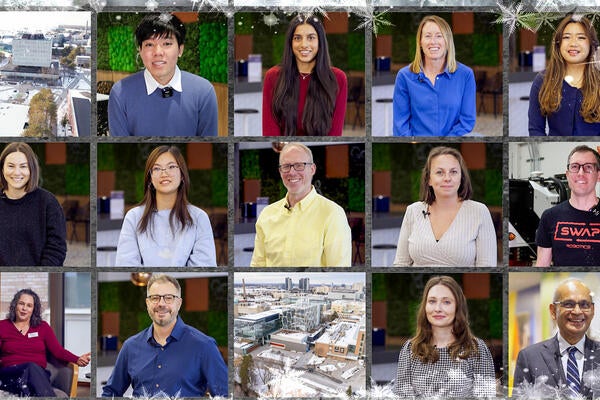
Technovation Girls Waterloo takes aim at gender gap in tech
Six regional teams progress to semi-final of global app development contest

Six regional teams progress to semi-final of global app development contest
By Jon Parsons Faculty of MathematicsThe Toronto-Waterloo innovation corridor employs more than 200,000 tech workers. As home to tens of thousands of tech companies and startups, the region is sometimes called Canada’s Silicon Valley. The corridor contributes some 17 per cent to Canada’s GDP.
Yet, for all the advancement on the tech and business side, the industry’s social development lacks in one key area: the gender gap.
According to research by the think tank Women in Communications and Technology, women make up only 21.4 per cent of tech-related jobs in the Canadian information, communications and technology sector. A McKinsey & Co. report suggests that it will take 140 years for women to achieve parity in Canadian scientific and technological fields.
But a global app development program and contest, Technovation Girls, is shaking things up in the tech industry, and some of this year’s top teams are from the Waterloo region. Six regional teams made it to the semi-finals.
“The tech industry is yet to see gender equity in representation of female, non-binary and trans people,” said Rae Samuel, chapter ambassador for Technovation Girls Waterloo. “It’s not easy to just walk into a computer science program. So, we try to work with students when they’re younger, particularly in middle school. The point is to foster interest and hopefully encourage them to continue to explore coding and technology.”
Along with the students and the chapter ambassadors, the program depends on sponsors to make it all happen. Locally based companies including Shopify, Terminal and D2L provide funding, equipment, coaches, mentors and contest judges.
The Women in Computer Science (WiCS) committee at the University of Waterloo, where Samuel is an outreach coordinator, spearheads the Waterloo Chapter of Technovation Girls. Tech giants Google, Facebook and Amazon, among others, are funders of WiCS.
“It really does take a village to run this program,” Samuel said.
Teams in Technovation Girls make apps that address a specific social need. As part of the program, students learn about the Sustainable Development Goals (SDGs), promoted by the United Nations. SDGs have categories for human health and well-being, climate action, poverty reduction and gender equality.
“I like how wholistic is it,” said Ellen Brisley, a 16-year-old Technovation participant whose team reached the semi-final for their app AIUTO. “It’s not just about the coding, and that’s what differentiates it from a hackathon. You’re not making an app for no reason. You have a purpose, and you can see how you can impact your community.”
AIUTO connects donors directly with charities, intending to create stronger relationships in the not-for-profit and NGO sectors. The name AIUTO means ‘help’ in Italian.
“We talked to the Red Cross women’s crisis services, the YMCA, and we talked to the retirement homes,” Brisley said. “We did surveys in the community to understand what organizations are doing. We put effort into understanding the problem because you can’t solve something you don’t understand. So, it was the need that drove the development of AIUTO.”
Other semi-final teams from the region created apps that likewise engage with significant issues of concern.
Evva Morrissey and her semi-finalist team in the junior division created an app called No Limits, specifically to address issues of accessibility for people with disabilities.
“We thought of all the places that if we were in a wheelchair, if we had a guide dog, or if we were blind, all the places we could or couldn’t go,” said Morrissey. “Our app shows maps with markers for places, showing accessible places that people can go. The app lets you search in your community, and if you come across places that aren’t in the app, you can add them.”
Asked how she got interested in coding and technology, Morrissey said it was primarily due to her exposure to the Technovation program, which she learned about through a presentation at her school.
“When I saw Technovation, I just decided to give it a try and see. Now I enjoy coding a lot more, especially knowing all the things you can do with it.”
Nicole Kremer is another Technovation participant whose love of coding and technology grew from her work in the program. Kremer, at age 12, is among the youngest semi-finalists from the region.
She says that once she learned about Technovation, it was something she felt compelled to do. Her team, called BTF (Building the Future), created an app especially for sick kids and kids in hospitals.
“Lots of kids feel isolated when they’re sick,” Kremer said. “Sick kids can have trouble making friends and can feel alone. The app helps sick kids connect with other kids from all over the world.”
Asked about the next steps for the app, Kremer said the idea is to take the “concept app” from Technovation and “make this a live app, so it is accessible to kids who are in hospitals or even clinics if they have to get check-ups.”
The teams in Technovation Girls submit their app to judges and create a demo video to promote their work. In the senior division of the program, participants also need to submit a complete business plan.
Team Hustle, another of the region’s semi-finalist teams in the senior category, took some four months from conceiving the idea for their app until it was complete. Then they also created the promotional videos and the business plan, which included proposals for financing, marketing, and ultimately for scaling up the app to a national or international audience.
“Our team’s name came from the hustle mindset,” said Paige Gugeler. “If you want a change in the world, you have to hustle and do it yourself. That’s part of our motivation. To hustle and make a change.”
Ramandeep Saini, the second member of the Team Hustle duo, also said that her motivation is to make a positive change in the world. That’s why the team set out to create an app to address one of the most significant issues facing young people today, mental health.
“We noticed the way that so many people in our age group were struggling with their mental health because of the pandemic,” said Saini. “We knew we had an opportunity to do something about it, and we wanted to see if we could help resolve the mental health issue, even in our small way.”
The result of Gugeler and Saini’s work is the Harmony App, which provides youth with specific mental health resources, self-care tips and motivates people to take care of themselves and their mental health.
For participants, the program fosters a desire to continue in tech and business, and this is precisely how Technovation Girls is pushing back against the gender gap in the tech industry.
Saini, for example, expressed a specific interest in startup culture and even in founding a startup one day. Brisley echoed this entrepreneurial spirit, saying that her goals are to “go into software engineering, maybe work at a startup, or just throw myself into that tech world.”
Other participants, like Gugeler, are a little more interested in the “business side of things,” but especially business for social good and a “business that’s focused on technologies that help people.”
This same motivation to work with technology and business in a way that contributes to the betterment of society is something even younger participants like Morrissey and Kremer take to heart – they both expressed a desire to work with technology and coding to help people.
This orientation to technology and entrepreneurship as a force for change certainly bodes well for the tech industry’s future in Canada and beyond. It cannot help but encourage more gender equity among those pursuing careers in scientific and technological fields.
Technovation Girls announces the overall winners at a global digital summit, August 12-13.

Read more
Here are the people and events behind some of this year’s most compelling Waterloo stories

Read more
A closer look at the University of Waterloo’s beloved network of pedestrian tunnels and bridges

Read more
A winter holiday message from President Vivek Goel
The University of Waterloo acknowledges that much of our work takes place on the traditional territory of the Neutral, Anishinaabeg, and Haudenosaunee peoples. Our main campus is situated on the Haldimand Tract, the land granted to the Six Nations that includes six miles on each side of the Grand River. Our active work toward reconciliation takes place across our campuses through research, learning, teaching, and community building, and is co-ordinated within the Office of Indigenous Relations.